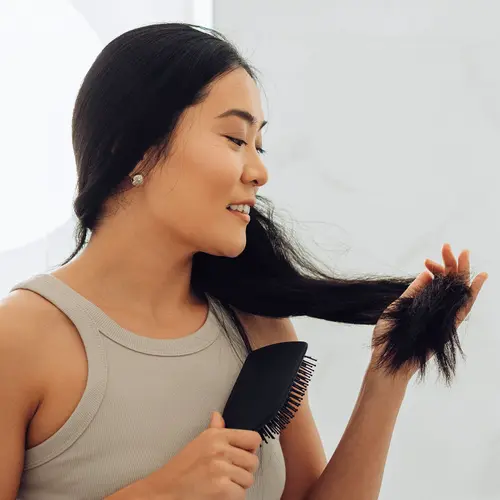The hair texture you grow up with becomes part of your identity. You learn to style it in a way that flatters you and fits your lifestyle. It can be unsettling if it changes. Over time, your hair may become curly, straight, thin, or coarse.
Many things can make hair change texture. Some you can't control. Others you may cause without knowing it.
Read on to see why your hair texture may be changing and what you can do to make the best of it.
The Cause: Graying
Gray hair grows when hydrogen peroxide builds up in your hair follicle. "This causes hair to bleach itself from the inside out," says Debra Jaliman, MD, a dermatologist in New York and spokesperson for the American Academy of Dermatology. Gray hairs are thicker and wirier, so your hair gets coarser as they multiply.
You can't do anything to stop graying -- it's something you inherit. But you can tame gray hair with a good hairstyle and special care.
Solutions: Shampoo and condition your hair with products designed for dry hair. Use a leave-in conditioner to help smooth coarser strands.
Occasional home or salon deep-conditioning treatments can also help, says Eugene Toye, senior stylist at Rita Hazan Salon in New York. He has styled hair for Sofia Vergara and Neil Patrick Harris.
Some hairstylists use keratin treatments to improve the rough texture of gray hair. But they are expensive and may contain unsafe levels of formaldehyde, which is known to cause cancer.
Toye suggests getting a cut that works with your new texture. "Don’t try to fight your hair," he says. "If it’s wavy, don’t try to get it stick straight."
The Cause: Chemotherapy
Chemotherapy can cause big changes in your hair texture or none at all. If you lose your hair during treatment, it may grow back thicker, curlier, or straighter all over or just in some spots.
Solutions: Over time, your hair may return to its pre-chemo texture. But the first hair that grows back is especially fragile. Avoid chemical processes like coloring or straightening for a while. And it's not just the early hair that's prone to damage. The skin on your scalp may be sensitive for 6 months or more after treatment.
Condition your post-chemo hair to help it grow back healthy. If you're not used to short hair, think of the grow-back period as a time to try out shorter styles. If you're really unhappy with hair that is coming in thin or patchy, Toye suggests wearing a hairpiece or wig while it continues to grow in.
The Cause: Over-Processing
“Any time you subject your hair to a chemical process like lifting color or taking away curl, you change the natural integrity of the hair,” Toye says. Over-processing leads to dry, brittle, rough, lackluster hair that can resist styling. So if your hair is straight, it won’t hold a curl, and vice versa.
Solutions: The less processing you do, the better for your hair. But once the damage is done, the only way to really get rid of it is to cut off the damaged hair and let healthy hair grow in.
Until you do, Toye suggests deep-conditioning treatments, protein packs, and moisturizing hair care products to make hair look healthier temporarily. Look for ingredients such as proteins, amino acids, and panthenol.
The Cause: Hormonal Changes
Hormones can have a big impact on women's hair. If you're pregnant, you may have thick and shiny locks. “Pregnancy gives most women the best hair that they will ever see," Jaliman says. But menopause and other hormonal imbalances can make your hair coarse and thin.
Solutions:Medications like over-the-counter minoxidil, prescription finasteride pills, and laser devices may keep your hair from thinning and regrow some hair. Thickening and body-boosting styling products can also add temporary volume.
Some experts recommend taking biotin, a B vitamin, daily to help thicken hair strands. Conditioners can give hair a smoother, silkier texture when used regularly.
A blunt haircut makes thin hair look fuller. “You don’t want to layer fine hair," Toye says. He also recommends using thickening products when styling, and letting your hair air-dry almost all the way before blow-drying.
“When you blow dry wet hair, the pulling takes away the hair’s natural body," Toye says. "If you let it dry naturally, then all you have to do is smooth the ends."
Hot rollers are another option. “The big fat ones are great for fine hair, and they only take a few minutes," Toye says.


